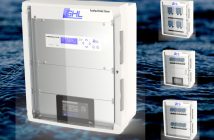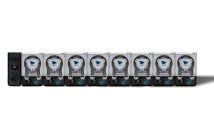For many years, the aquarium industry was limited to a small assortment of powerheads. On one hand, you had the cheap pumps that put out a couple hundred gallons per hour (gph) through a tiny opening. At the opposite end of the spectrum, you had pumps that put out a lot of flow from a much wider opening, but were excruciatingly expensive. Somewhere in the middle was a tiny selection of pumps that most people seemingly avoided for whatever reason. This all changed dramatically when Hydor introduced the Koralia powerhead.
A few years ago, Hydor broke open the powerhead market by bringing the Koralia powerhead onto the scene. These pumps provided the high flow performance that many reef keepers were demanding, while staying cheaper than the high dollar pumps that were dominating the market at the time. Additionally, the Koralia pumps were only slightly more expensive than the low-end pumps, but outperformed the lower-end pumps tremendously. Originally, four models were available. These were labeled as the Koralia 1, 2, 3, and 4. A fifth model, the Koralia Nano, was added shortly after the introduction of the original four in order to target the smaller tank crowd. The Koralia 1 moved 400 gph while the 4 moved 1200 gph. The amount of energy used for these pumps is very minimal. The range for watts absorbed is 3.5 with the Koralia 1 (also with the Nano), reaching up to 12 watts with the Koralia 4.
In addition to water moving performance, the Koralia introduced a lot of the higher-end pump designs to the lower-end pump crowd. The most notable of which is the magnetic/suction cup mounting hardware used to attach the pump to the side of the aquarium. The pump utilizes a large suction cup, but also a magnet mount on either side of the glass. This is a vast upgrade over the standard suction cups that came with the lower-end pumps, which would easily degrade and fail over a short period of time in a saltwater environment. The Koralia also utilized a ball joint on which it could pivot from the magnet. This would allow the pump to remain in its mounted position, but direct flow in virtually every direction.
 *Photo Courtesy of Marine Depot
*Photo Courtesy of Marine Depot
 *Photo Courtesy of Marine Depot
*Photo Courtesy of Marine Depot
Despite its tremendous benefits, the Koralia wasn’t without its shortcomings. For one, the pumps originally didn’t exceed 1200 gph. This has changed within the past year, but the price also jumped a bit (more on this in a moment). Secondly, the pumps were not originally controllable like the higher end pumps on the market at the time. As with the flow, this has also changed, but the price jumped dramatically with this upgrade (more on this in a moment). Another pump downfall was the weakness of the magnet. While it would hold a pump to the standard sized aquarium glass, custom tanks proved to be a challenge as they are usually made of thicker glass. Lastly, the Koralia has run into some electricity leaking problems. This is when an electrically powered device that is in an aquarium leaks stray voltage into the tank. You can feel the voltage on your hand (usually through a small wound).
In response to demand for more powerful powerheads, Hydor released the Magnum series of pumps. The Koralia Magnum series added four more pumps the original lineup and included the Magnum 5, 6, 7, and 8. The 6 has an output of 1650 gph (up from the 1200 gph provided by the Koralia 4), while the 8 sports a whopping 3250 gph. Like with the original pumps, the energy usage by the Magnums stayed at a minimum, reaching only 19 watts with the Magnum 8. Despite all this, the Magnum series showed some tough setbacks, some of which were present in the original lineup. The magnet strength virtually stayed the same, which would mean people with thicker tanks would have to look elsewhere for water movement. Additionally, the Magnums were much larger than the original Koralia powerheads, causing the pumps to drastically stand out in the tank. But I think the biggest drawback to the Magnum pumps were their prices. The cheapest one (the Magnum 5) started out at $135, more than two times the cost of a Koralia 4, but an increase of only 250 gph.
 *Photo Courtesy of Marine Depot
*Photo Courtesy of Marine Depot
To appease the controller happy crowd, Hydor introduced a third line of pumps which could be controlled to simulate wave movement. Simply dubbed the Controllable Koralia, this setup took the original four pumps and the Nano, increased their respective flow outputs, and altered their power cord to include a proprietary connection to a Hydor controller box. The original controller could regulate two pumps, but Hydor would later release a 4-way controller that could obviously operate four individual pumps. The major downside to the controllable Koralias was the massive price of the controller itself, along with the increase in pump prices. The 2-way controller hit the wallet at $300, while the 4-way cost $100 more. Compared to other systems on the market, the Controllable Koralias aren’t able to create the same sort of wave action that competitors could create, and costs are close enough to each other to not be much of a factor. © 2009 Drs. Foster and Smith, Inc.
© 2009 Drs. Foster and Smith, Inc.
Overall though, the Hydor Koralia powerhead is a great powerhead for the budget-minded and eco-friendly reefkeeper. They are relatively inexpensive and barely use any power, causing the Koralia to gain a lot of popularity in a very short time period. They are great entry-level pumps, but do a wonderful job on more advanced setups as well.
Permissions and Sources:
© 2009 Drs. Foster and Smith, Inc.
Reprinted as a courtesy and with permission from
DrsFosterSmith.com (http://www.DrsFosterSmith.com)
Free pet supply catalog: 1-800-323-4208






